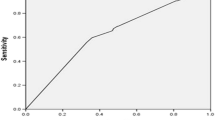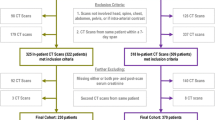Abstract
Purpose
Acute trauma patients are at risk for the development of acute kidney injury (AKI). One potential nephrotoxic agent, which a trauma patient may be exposed to, is iodinated contrast media (ICM). We aim to review the incidence and outcome of contrast-induced nephropathy (CIN) in trauma patients in a busy trauma service, and to identify potentially modifiable risk factors.
Methods
During the period from December 2012 to April 2017, all patients who underwent a contrast-enhanced CT scan for trauma were included. Data were examined and outcome data were reviewed.
Results
A total of 1566 patients required a CT scan following blunt trauma at our institution. Of this total 755 patients underwent a contrast-enhanced CT scan. There were 173 females (22.9%) and 582 males (77.1%). All these patients received intravenous contrast. A total of 143 (18.9%) were admitted to ICU, and 58 (7.7%) of patients died. Detailed electrolyte studies pre- and post-procedure were available for 312 patients. Of these 312 patients, 46 developed CIN (14.7%).There was no difference in the incidence of pre-CT AKI or deranged electrolytes between the patients who developed CIN and those who did not. The development of CIN was associated with an increased risk of death as well as increased need for renal replacement therapy as well as increased need for ICU.
Conclusion
Contrast-induced nephropathy is a real risk in trauma patients undergoing contrast-enhanced CT scan for blunt trauma in our environment. Further work is needed to define and delineate risk factors.
Similar content being viewed by others
References
Katzberg RW, Newhouse JH. Intravenous contrast medium-induced nephrotoxicity: is the medical risk really as great as we have come to believe? Radiology. 2010;256(1):21–8. https://doi.org/10.1016/2Fj.yrad.2011.01.017.
https://kdigo.org/wp-content/uploads/2016/10/KDIGO-2012-AKI-Guideline-English.pdf. Accessed 17 Sept 2018.
Morcos SK, Thomsen HS, Webb JA. Contrast-media-induced nephrotoxicity: a consensus report. Contrast Media Safety Committee, European Society of Urogenital Radiology (ESUR). Eur Radiol. 1999;9:1602–13. https://doi.org/10.1007/2Fs003300050894.
Mitchell AM, Jones AE, Tumlin JA, et al. Incidence of contrast-induced nephropathy after contrast-enhanced computed tomography in the outpatient setting. Clin J Am Soc Nephrol. 2010;5:4–9. https://doi.org/10.2215/2Fcjn.05200709.
Kooiman J, Pasha SM, Zondag W, et al. Meta-analysis: serum creatinine changes following contrast enhanced CT imaging. Eur J Radiol. 2012;81:2554–61. https://doi.org/10.1016/2Fj.ejrad.2011.11.020.
Barrett BJ, Carlisle EJ. Metaanalysis of the relative nephrotoxicity of high- and low-osmolality iodinated contrast media. Radiology. 1993;188:171–8. https://doi.org/10.1148/2Fradiology.188.1.8511292.
Colling KP, Irwin ED, Byrnes MC, et al. Computed tomography scans with intravenous contrast: low incidence of contrast-induced nephropathy in blunt trauma patients. J Trauma Acute Care Surg. 2014;77(2):226–30. https://doi.org/10.1097/2Fta.0000000000000336.
Laing GL, Skinner DL, Bruce JL, et al. Understanding the burden and outcome of trauma care drives a new trauma systems model. World J Surg 2014;1699–706. https://doi.org/10.1007/2Fs00268-014-2448-8.
Clarke DL, Aldous C, Thomson SR. The implications of the patterns of error associated with acute trauma care in rural hospitals in South Africa for quality improvement programs and trauma education. Injury. 2013. https://doi.org/10.1016/j.injury.2013.04.011.2.46.
Laing GL, Bruce JL, Aldous C, et al. The design, construction and implementation of a computerized trauma registry in a developing South African metropolitan trauma service. Injury. 2014;45(1):3–8. https://doi.org/10.1016/j.injury.2013.05.013.2.46.
Skinner DL, Hardcastle TC, Rodseth RN, et al. The incidence and outcomes of acute kidney injury amongst patients admitted to a Level I Trauma Unit. Injury Int J Care Injured 2014;45(2014): 259–64. https://doi.org/10.1016/2Fj.injury.2013.07.013.
Skinner DL, Laing GL, Bruce J, Biccard B, Muckart DJJ. Validating the utilisation of venous bicarbonate as a predictor of acute kidney injury in crush syndrome from sjambok injuries. S Afr Med J. 2017;107(5):446–50. https://doi.org/10.7196/SAMJ.2017.v107i5.12213.
Author information
Authors and Affiliations
Contributions
AAB: primary author, data analysis. VK: analysis and drafting. DS: manuscript editing and assistance with statistics. GL: design of data capture instrument. JB: database maintenance and data retrieval. PB: drafting, reference checking. DC: senior author, general supervision, co-ordination and assistance at all levels.
Corresponding author
Ethics declarations
Conflict of interest
AAB, VK, DS, JB, GL, PB, DC declare no conflict of interest relevant to this manuscript.
Research involving human participants and/or animals
This article does not contain any studies with human participants or animals performed by any of the authors.
Ethical approval
We have ethics approval to keep and use this database (BE 207/09, 221/13).
Rights and permissions
About this article
Cite this article
Bashir, A.A., Kong, V., Skinner, D. et al. Contrast-induced nephropathy following CT scan for trauma is not rare and is associated with increased mortality in South African trauma patients. Eur J Trauma Emerg Surg 45, 1129–1135 (2019). https://doi.org/10.1007/s00068-018-1008-6
Received:
Accepted:
Published:
Issue Date:
DOI: https://doi.org/10.1007/s00068-018-1008-6




